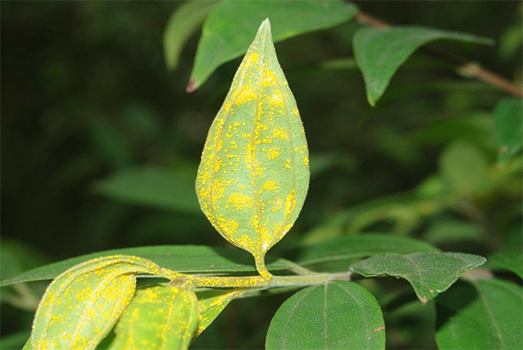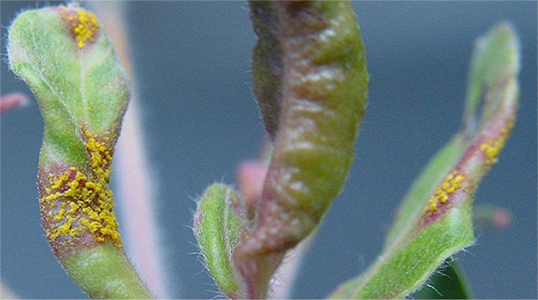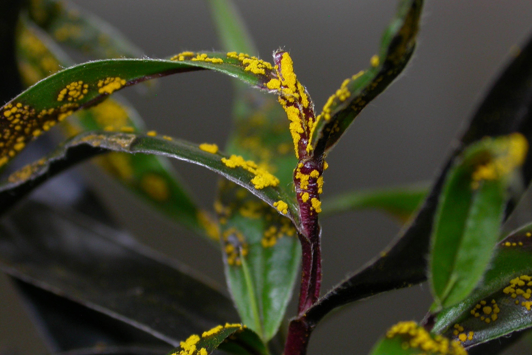Look and report
Myrtle rust is a declared pest in Western Australia.
Myrtle rust has only been reported from a remote northern part of Western Australia (WA) and must be reported to the department if found or suspected to be present in the State. Bushwalkers and travellers are urged to look out for and report plants with signs of myrtle rust and take precautions when travelling in and out of affected areas to reduce the spread.
What is myrtle rust?
Myrtle rust, caused by the fungus Austropuccinia psidii, is a serious disease that can infect and kill many of WA’s tree species. Myrtle rust was first discovered in Australia in April 2010 in a New South Wales nursery. It has now been detected in Queensland, Victoria, Tasmania, Northern Territory and most recently on an isolated property in the northern part of Western Australia. Further information about myrtle rust is available on the Department of Biodiversity, Conservation and Attractions website.

What plants are affected?
Myrtle rust affects plants in the Myrtaceae family including eucalypts, bottlebrushes, paperbarks, turpentine, tea tree, lilly pilly and peppermint trees.
What do I look for?
- Myrtle rust is readily identified by its unique bright yellow or orange spores or pustules on leaves.
- Myrtle rust attacks young, soft, actively growing leaves, shoot tips and stems. It also attacks fruit and flowers of susceptible plants.
- The first signs of rust infection are tiny, raised spots or pustules. After a few days, the pustules may turn a distinctive egg-yolk yellow colour.
What damage can this disease cause?
Many of WA’s tree species can be infected and killed by myrtle rust. Myrtle rust could also damage eucalyptus or oil mallee plantations, apiculture, the cut native flower trade and the garden industry, and its spread could affect tourism if natural landscapes were badly damaged.
Legal duty to report
Myrtle rust only occurs in a remote part of northern WA. Austropuccinia psidii (G. Winter) Beenken (2017) is a declared pest under section 12 of the Link Biosecurity and Agriculture Management Act 2007.
This means that any person who finds or suspects the presence of myrtle rust must report it to the department.

You can help stop the spread of myrtle rust
WA bushwalkers and travellers to northern WA are encouraged to look and report signs of myrtle rust. If you see signs of myrtle rust:
- Avoid contamination of yourself and any equipment with the spores.
- Take a photograph (do not collect samples or handle the plant).
- Record the location of the infected plant(s) - GPS is ideal, but a detailed description of the location is important.
- Record what you see (what the infection looks like, the extent of the infection, how many plants are infected etc.). If you know the species of plant infected, record that as well.
- As soon as you can, report your observations.
WA's control of myrtle rust is supported by general and specific surveillance and specific import requirements to prevent its entry.
How does myrtle rust survive and spread?
Wind naturally disperses myrtle rust spores to new areas, but the tiny spores are highly transportable and can stick to clothing, hats, footwear, vehicles and equipment. Anyone who visits areas known to be affected by myrtle rust should take the following precautions:
- If travelling by road, shake out floor mats, wash down tyres and check that the vehicle, caravan, trailer and any gardening equipment contain no plant material. Do this before leaving an infected area and do it again before entering areas that could be affected by myrtle rust.
- If possible, change into fresh clothing and footwear and pack away anything that was worn in myrtle rust infected areas. If possible, clean all contaminated clothing and items before leaving the area and returning home, otherwise once home, wash everything that was used on the trip.
- Travellers are reminded that any plant material or items contaminated by soil are prohibited entry into WA.
Control and management
Myrtle rust can be controlled by chemicals such as copper oxychloride, triforine, mancozeb, tebuconazole and trifloxystrobin in the home garden, but chemical control is not a viable option for large-scale landscapes, native forests and other natural ecosystems.
-
Myrtle rust - biosecurity alertpdf (2.01 MB)

